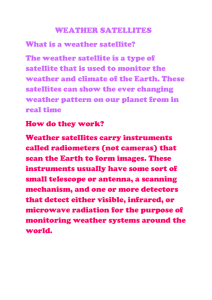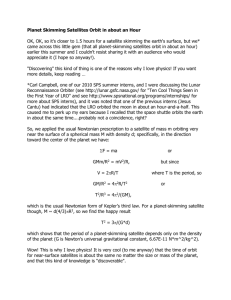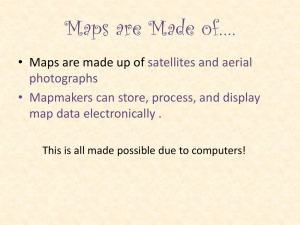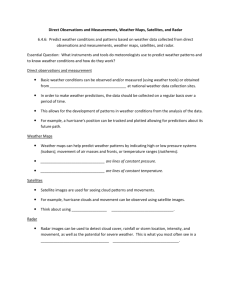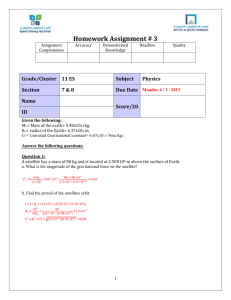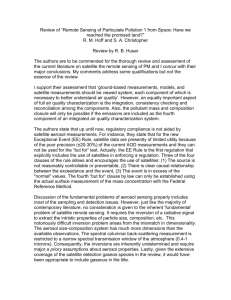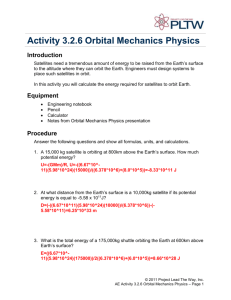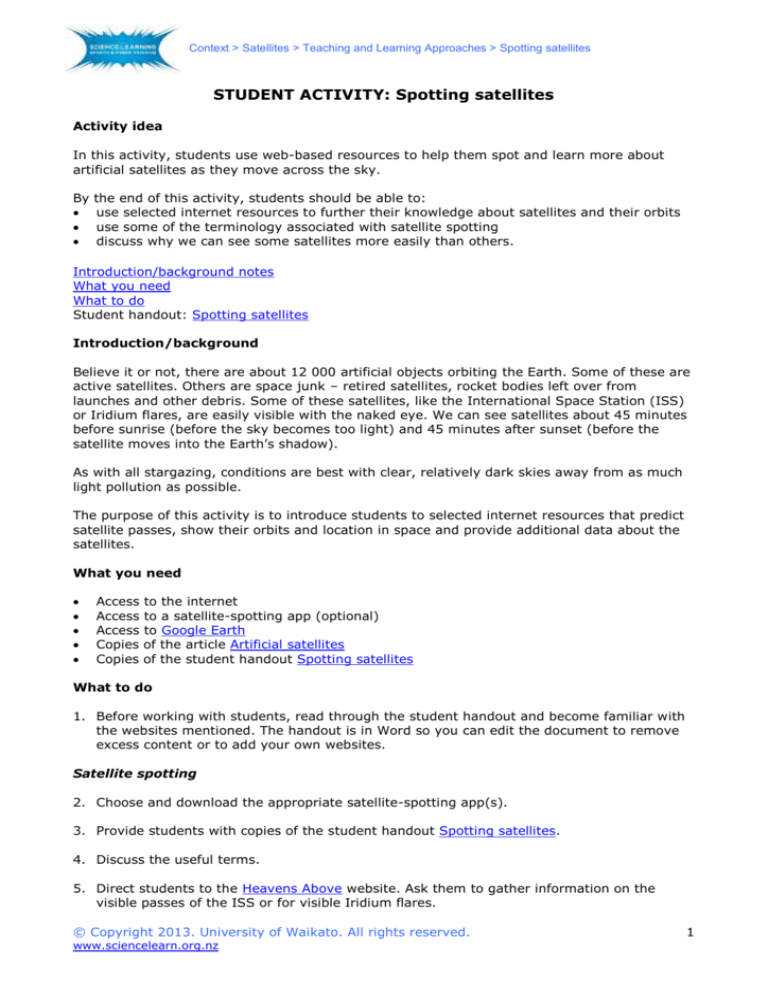
Context > Satellites > Teaching and Learning Approaches > Spotting satellites
STUDENT ACTIVITY: Spotting satellites
Activity idea
In this activity, students use web-based resources to help them spot and learn more about
artificial satellites as they move across the sky.
By
the end of this activity, students should be able to:
use selected internet resources to further their knowledge about satellites and their orbits
use some of the terminology associated with satellite spotting
discuss why we can see some satellites more easily than others.
Introduction/background notes
What you need
What to do
Student handout: Spotting satellites
Introduction/background
Believe it or not, there are about 12 000 artificial objects orbiting the Earth. Some of these are
active satellites. Others are space junk – retired satellites, rocket bodies left over from
launches and other debris. Some of these satellites, like the International Space Station (ISS)
or Iridium flares, are easily visible with the naked eye. We can see satellites about 45 minutes
before sunrise (before the sky becomes too light) and 45 minutes after sunset (before the
satellite moves into the Earth’s shadow).
As with all stargazing, conditions are best with clear, relatively dark skies away from as much
light pollution as possible.
The purpose of this activity is to introduce students to selected internet resources that predict
satellite passes, show their orbits and location in space and provide additional data about the
satellites.
What you need
Access
Access
Access
Copies
Copies
to the internet
to a satellite-spotting app (optional)
to Google Earth
of the article Artificial satellites
of the student handout Spotting satellites
What to do
1. Before working with students, read through the student handout and become familiar with
the websites mentioned. The handout is in Word so you can edit the document to remove
excess content or to add your own websites.
Satellite spotting
2. Choose and download the appropriate satellite-spotting app(s).
3. Provide students with copies of the student handout Spotting satellites.
4. Discuss the useful terms.
5. Direct students to the Heavens Above website. Ask them to gather information on the
visible passes of the ISS or for visible Iridium flares.
© Copyright 2013. University of Waikato. All rights reserved.
www.sciencelearn.org.nz
1
Context > Satellites > Teaching and Learning Approaches > Spotting satellites
6. Choose a date and time to spot a satellite. Take the students outside and let them practise
locating the azimuth and altitude for that particular satellite pass.
7. While outside, use a satellite-spotting app to locate any satellites that might be overhead.
8. Views of the ISS will most likely occur outside of school hours. Encourage students to note
the satellite-spotting details in their phones or diaries so they remember to do it!
Viewing satellites on the internet
9. For online satellite viewing, introduce your students to the Google Earth and NASA Eyes on
the Earth websites. Take them on a tour of the sites via an IWB or data projector.
10. Give students the opportunity to use the sites on their own or give them some search
tasks. For example:
Using Google Earth and the Heavens Above sites, find:
a satellite with a perigee within 500 km of the Earth
a satellite with an apogee of more than 30 000 km above the Earth
a satellite whose perigee and apogee differ by more than 2000 km – what is the shape
of its orbit? (Hint: search for Japan’s Akebono satellite.)
a satellite whose perigee and apogee are similar – what is the shape of its orbit? (Hint:
search for Australia’s Optus D1.)
a satellite owned by a particular country
a satellite whose mission is navigation
a satellite whose mission is communication
a satellite whose mission is unknown – make a guess as to why!
a satellite with a period under 100 minutes
a satellite with a period of over 1000 minutes
a satellite you are likely to spot within the next week due to its magnitude.
Using Eyes on the Earth site, choose a mission such as AQUA or OSTM and find:
the satellite’s mission
the satellite’s size in relation to a human being or a school bus
the types of datasets the satellite collects and are displayed on the site.
© Copyright 2013. University of Waikato. All rights reserved.
www.sciencelearn.org.nz
2
Context > Satellites > Teaching and Learning Approaches > Spotting satellites
Student handout: Spotting satellites
Believe it or not, there are about 12 000 artificial objects orbiting the Earth. Some of these are
active satellites. Others are space junk – retired satellites, rocket bodies left over from
launches and other debris. Some of these objects can be seen with the naked eye. We can see
satellites about 45 minutes before sunrise (before the sky becomes too light) and 45 minutes
after sunset (before the satellite moves into the Earth’s shadow). As with all stargazing,
conditions are best with clear, relatively dark skies away from as much light pollution as
possible.
This handout helps you locate and view a few of the low Earth orbit satellites (such as the
International Space Station and Iridium communication satellites) as they pass overhead.
Additional references provide information about the orbits, owners and functions of some of
the thousands of satellites that orbit our planet.
Useful terms
Here are some terms and definitions that you will find useful when using satellite-spotting
websites:
Apogee – the point in a satellite’s orbit at which it is farthest from the Earth.
Azimuth – corresponds to compass headings on the viewer’s horizon. 0° corresponds to
true north, 90° to east, 180° to south and 270° to west. The azimuth changes as the
satellite makes its pass.
Altitude – (also known as elevation) the angle of the satellite, above the local horizon, at
the start of its pass. A satellite with an altitude of 0° is on the viewer’s horizon. A satellite
with an altitude of 90° is directly over the viewer’s head. A simple method to determine
altitude is to hold your fist out at arm’s length. The width of the fist is approximately 10°.
The altitude changes as the satellite makes its pass.
Magnitude – for satellite spotting, magnitude indicates the brightness of the object. A lower
value corresponds to a brighter pass. For example, the Sun is magnitude (mag.) -27, the
full Moon is mag. -12.5 and faint stars visible to the naked eye under good viewing
conditions are mag. +6.
Perigee – the point in a satellite’s orbit at which it is nearest to the Earth.
Period – the time it takes a satellite to make a full orbit of the Earth. Satellites close to the
Earth (at an altitude of 100 km) need to move at 28 000 km/hr to stay in orbit. At an
altitude of 36 000, a satellite needs to travel at 11 000 km/hr. A satellite with a low Earth
orbit has a much shorter period than those further away.
Heavens Above
The website www.heavens-above.com provides prediction services for bright satellites. Here
are a few notes to help you navigate the site.
Configuration
This section lets you choose your observation site.
By clicking on ‘select from map’, you link to Google
Maps. Select your location on the map and click on
the submit button. This will save your location in
Heavens Above. All satellite predictions are now
based on your individual observation site.
Satellites
This section provides information on a number of
satellite passes.
© Copyright 2013. University of Waikato. All rights reserved.
www.sciencelearn.org.nz
3
Context > Satellites > Teaching and Learning Approaches > Spotting satellites
A good place to begin is ISS (International Space Station). This is a low Earth orbit satellite.
Click on ISS to get start times and dates for all of the ISS passes. Alternatively, narrow your
search and select for ‘visible only’ passes.
An information table is generated that lists brightness (magnitude), start (time, altitude and
azimuth), highest point (time, altitude and azimuth) and end (time, altitude and azimuth) to
guide your spotting.
Use the navigation tabs in the upper right-hand corner to find out more about the ISS. The
Info tab gives additional details and a photo of the ISS. The Orbit tab provides multiple views
of the satellite’s orbit as well as data on perigee and apogee height, revolutions per day and
much more. (Similar information is given for most of the satellites featured in this site.)
Iridium flares (listed under the ‘Satellites’ heading) are another way to observe satellites. The
Iridium satellite constellation consists of 66 active satellites in low Earth orbit. They are
relatively small and difficult to see on their own, but their antennae are made of highly
reflective aluminium plates. The antennae act like mirrors and reflect sunlight back to the
Earth. These flashes of light (flares) last from 5 to 20 seconds. Some of flares are visible
during the daytime.
Apps for spotting satellites
There are various apps available to spot satellites as they move over your location. Following
are two Android apps and an iPhone app available at the time this resource was published. An
internet search may reveal other apps.
The WhatSat Satellite Explorer app (http://whatsat.net/) identifies 150 of the brightest
satellites as they fly over. It also tells you where to look for satellites.
Satellite AR (http://spacedata.agi.com/MobileApps/about.htm) is an augmented reality app
that uses your phone’s camera to display the location and tracking of various satellites.
Colour-coded tracks highlight which satellites are visible to the naked eye.
Iridium Flares (www.montanamedia.nl/apps/iridium-flares) is an app that lists the Iridium
flares that are visible on your location for the next 7 days. The only necessary thing to see
them is a clear sky.
Viewing satellites on the internet
If you want to spot satellites without having to go outside, there are many websites with
satellite orbits and other data. Here are two to help you get started.
Google Earth
The Google Earth Library AGI Satellite Tracking site www.gelib.com/agi-satellite-tracking.htm
is a database of artificial satellites orbiting the Earth. This site provides details about
thousands of objects including the owner, launch date and a visualisation of the satellite’s
orbit.
Download the information by clicking on the Download With Google Earth
button.
To use this information in Google Earth, click on the ‘Places’ section in the left-hand navigation
panel. Open the Satellite Database folder. There you can find additional folders for Active
Satellites, Inactive Satellites, Debris and Rocket Bodies. Opening all four folders and zooming
to or away from the Earth shows the amazing number of satellites orbiting our planet. Closing
a folder (for example, Debris) will remove those satellites from the screen.
Satellite names are colour coded according to their category. Active satellite names are shown
in green, inactive satellites are brown, rocket bodies are in purple and debris is in yellow.
© Copyright 2013. University of Waikato. All rights reserved.
www.sciencelearn.org.nz
4
Context > Satellites > Teaching and Learning Approaches > Spotting satellites
Clicking on an individual satellite displays a pop-up box with information about that particular
satellite. Clicking on Display Trajectory in Fixed Frame shows the satellite’s orbit.
You can view which countries have launched satellites. Go to the ‘Places’ section in the lefthand navigation panel. Each of the four satellite categories has an arrow to its left. Click on
this arrow to reveal nearly 60 folders. Clicking on the arrow to the left of the country’s
abbreviated name reveals the names and numbers of its satellites. The International Space
Station has its own folder (ISS).
NASA
NASA’s Eyes on the Earth (http://eyes.nasa.gov/earth/) site features 16 NASA satellites that
monitor the Earth from space. These satellites collect data about Earth’s atmosphere, land and
oceans. Chose a satellite by clicking on the ‘Missions’ icon on the top navigation bar. Use the
right-hand navigation panel to access information about the satellite’s mission and the
datasets it collects. The data is in graphic or pictorial form so there are no difficult statistical
tables to work through! You can also see the orbit of your chosen satellite. Clicking on the
orbiting satellite not only allows you to see the satellite’s configuration but it also provides a
bird’s eye flyover of the Earth.
To learn more about present, past and developing NASA satellite missions, visit
http://nasascience.nasa.gov/missions/. Click on the column headers to sort the missions by
division (Earth or planetary, for example), satellite name, launch date and whether the
satellite is currently in operation.
To search for an individual spacecraft name, for example Optus D1, use NASA’s National Space
Science Data Center Master Catalog Search
http://nssdc.gsfc.nasa.gov/nmc/SpacecraftQuery.jsp. The site provides a description of the
satellite along with its orbit, purpose and facts about its launch.
© Copyright 2013. University of Waikato. All rights reserved.
www.sciencelearn.org.nz
5

